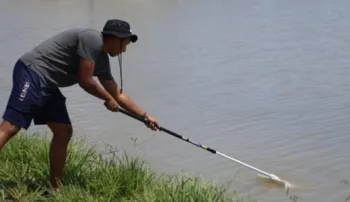Additional authors: Dima Jones (Student 3, UC Davis) and Cara Razma (Student 3, UC Davis)
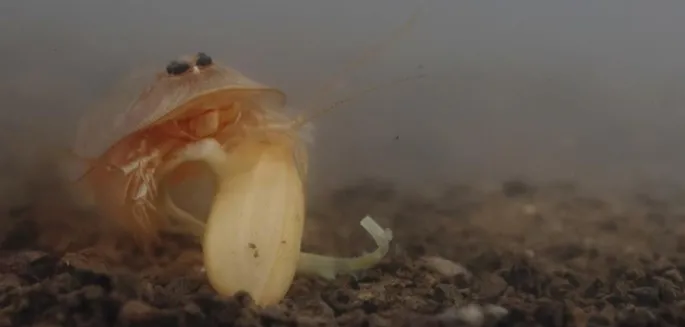
In muddy rice fields where the water lies still, Tadpole shrimp lurk with a sneaky-slick skill. They're brown like the bottom, they blend in just right, And then—bam!—they appear, a big buggy fright! They grow super fast, from a speck to a brute, And ruin young rice with a mud-churning scoot!
Scouting for insect pests is the cornerstone of any good IPM game plan; you're spotting them before they cause too much trouble, but not pulling the trigger on an application too early. By regularly checking the fields and keeping tabs on who’s hatching, crawling, or munching, growers can catch problems early and decide if action is really needed. It’s not just about spotting trouble; it’s about timing, thresholds, and making informed choices. Rather than spraying “just in case,” scouting lets you know if, when, and where you need to take action. It saves money and reduces unnecessary insecticide use and helps prevent insecticide resistance.
For tadpole shrimp, scouting is not the easiest. They are pretty easy to see once they are large and zooming around, stirring up mud. But at this point, the shrimp are likely already causing damage, could be more difficult to kill with some insecticides, and may make applications rushed and time-crunched. The ability to scout has become important in cases where resistance to lambda-cyhalothrin has developed; alternative materials are more expensive and may not work as well as pyrethroids against large shrimp. A common tactic is to simply look into the flooded fields. However, seeing them when they are smaller is difficult even with clear and relatively calm water. They are fairly well camouflaged. A clear-bottomed bucket could you help you peer into the water. It is not easy to use from the edge though, and many seem to balk at sticking their head down into the bucket, especially once the summer temps start rising. You’re only searching a relatively small area at a given time point.
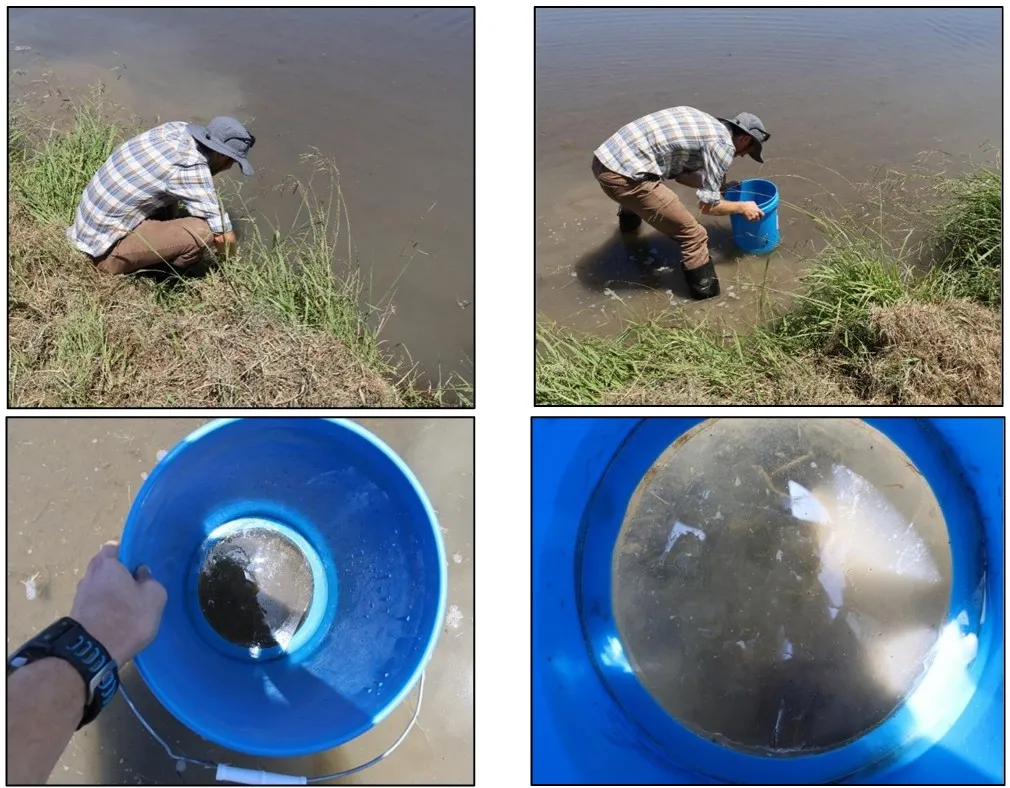
What about if the water is stirred up? Good luck seeing through the silty water and seeing any small or medium shrimp just by staring into the water. The shrimp may be lurking in the muddy water, growing, and then munching on rice.
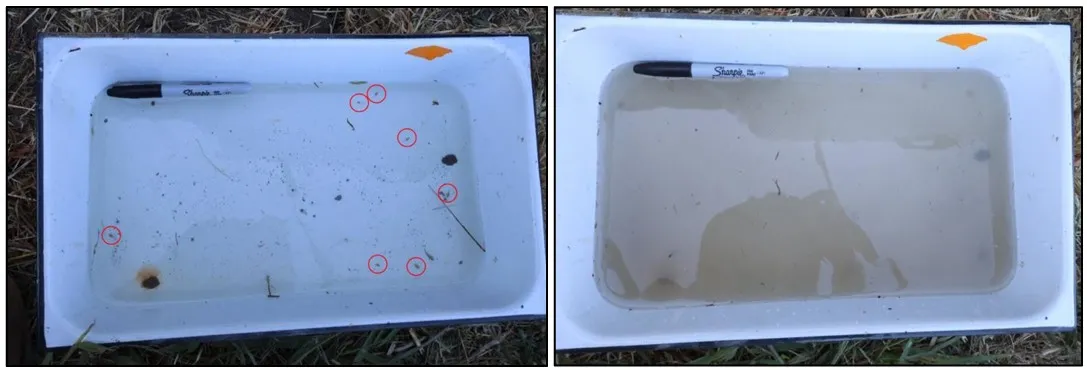
Difference between clear and murky water in finding tadpole shrimp. Note differences (with a best-case scenario white background) in detectability of tadpole shrimp depending on how muddy the water is. Shrimp are small here, see permanent marker for size.
A more effective/efficient and easier to use scouting method is sorely needed. We aimed to improve the ability of growers and pest control advisors to scout for shrimp. This sampler project was part of a larger project funded by the Department of Pesticide Regulation. We wanted something that was:
- Effective (catches lots of tadpole shrimp)
- Efficient, able to detect shrimp quickly.
- Easy overall to use
- Able to collect small tadpole shrimp
- Able to sample tadpole shrimp even if the water was completely muddy
We started with the goal of creating sort of scoop with a handle that could be used to scoop up shrimp efficiently while also minimizing the debris and mud in particular that ended up in the scoop. We had previously used a pool net with a flat leading edge and dragged it along the bottom. While this worked to collect many shrimp, they also ended up completely covered in mud. This made counting them difficult and also limited their movement, which made seeing them at all a challenge.
For simplicity, we started by modifying a sand flea rake. This was a simple way to start because it streamlined the process and let us test the general idea as a concept. A sand flea rake had an overall scoop frame and handle, although we needed to make two modifications to create something more akin to our target design. The first was to simply add wire mesh to decrease the space between holes; a sand flea rake is designed to collect much larger arthropods. The second was to add runners or rollers/wheels to the lower edge of the rake head, which would be critical to avoid scooping up lots of mud, algae, and rice. We decided to start with a runner-type of design, which was something we stuck with moving forward. These runners were clipped onto the rake. We designed the runners using CAD and then 3D printed them.
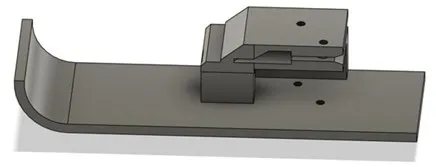
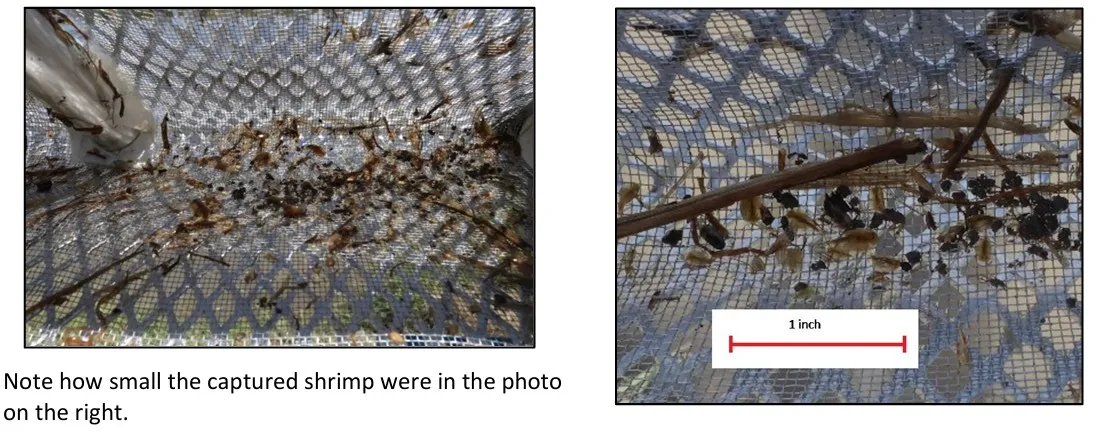
In our first field tests in 2024, the design seemed to be a resounding success. We standardized a sample as two scoops, reaching out, pulling the sampler in, repeating, and then counting and rinsing the sampler. The rake was pretty easy to use. One sample took 30-40 seconds to take from start to finish. The sampler was efficient (shrimp per unit time), easy to use, was unaffected by water murkiness, and importantly, caught small shrimp.
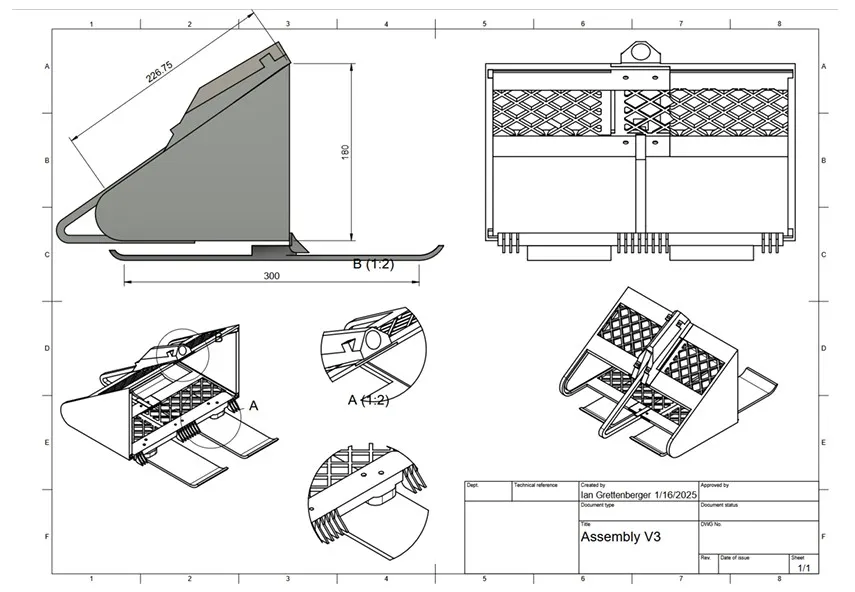
Going into the 2025 season, we planned to design the sampler from the ground up; we used CAD again and then 3D-printed prototypes with the goal of producing a fully 3D-printed sampler, aside from the handle. For the handle, we planned to use an extendable paint roller extension pole. We learned lessons from the first prototype and our tests in the field and incorporated them into this design. We would attach components together with bolts and create a design that allowed for integration of the mesh with no taping and minimal to no gluing. Mesh and bolts would be the only additional materials needed for the sampler itself.
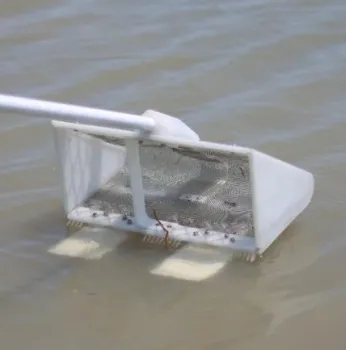
We took these Version 2 samplers to the field and were impressed with how well they worked. In a couple of separate tests, they were very easy to use and found small tadpole shrimp. We also compared to the bucket and a visual assessment. This year though, the water in one field was muddy and these sampling methods produced no shrimp. We could see a few shrimp swimming around when looking at the field more broadly, but that was it. The sampler, meanwhile, cut through the silty water and extracted shrimp. The paint roller extension handle stored short for transportation and then could be expanded when ready for use.
Close up of the catch area for Version 2 of the sampler. While tadpole shrimp can be somewhat difficult to see here in a photo, they will move when first removed from the water and can be more easily counted.
Next steps? We plan to produce more of these samplers for folks to use and try out in the 2026 season. We hope that they can help facilitate more finely tuned management plans. We also hope that it’ll make it simply easier overall to scout, which should also help make it easier to get insecticide applications out in time. There are plenty of things to keep people busy during tadpole shrimp season, and this tool could take some of the guesswork and gruntwork out of pest management in the early season. Stay tuned, we’ll keep sharing updates as we move this forward or refine the design and would love to hear feedback from anyone.

Funding for this project has been provided in full or in part through a Grant awarded by the Department of Pesticide Regulation
